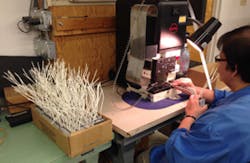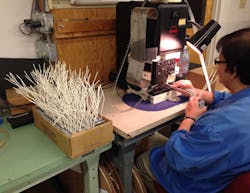Many OEMs don’t have the in-house infrastructure to build every component and sub-assembly from scratch. (Photo courtesy of Electro-Prep)
OEMs must weigh the benefits of doing in-house work on eletromechanical assemblies against the costs, such as higher facility overhead, including additional required inventory, manufacturing space, equipment, trained labor, as well as engineering and purchasing resources. Many times, outsourcing such work can be the better option when in-house work is out of the OEM's area of expetise. Doemstic outsourcing can cut costs, improve quality, and even speed delivery. However, there are a few pitfalls OEMs should be aware of when making the decion to outsource.
1. Quality/ Workmanship Nightmares: The fact is as many as 44 percent of electronic failures are the result of poor quality control. A key element in ensuring quality is assuring the supplier has their ISO 9001:2008 certification (quality and strong process controls). Combine this with IPC/WHMA-A-620 training and certification (industry assembly standards), as well as J-STD-001 training and certification (soldering standards), and you have a pretty good idea that your supplier is a true professional and takes its partnership with you very seriously.
2. Picking the Lowest-Priced Supplier: If the lowest-priced company delivers a poorly built assembly, the cost to fix the problem may be much higher, and the cost to the company reputation may be irreplaceable. A good manufacturer should offer a competitive price but it may not be the lowest. Make sure to consider the total cost of doing business in making your decision.
READ ALSO: Q&A – The True Cost of Electromechanical Assemblies?
3. Delivery Hassles: When production deliveries are on the line, many suppliers fail to understand the importance of same-day, next-day, or even on-time delivery. Using outdated methods, planning, and equipment as well as poor inventory control contributes to many delivery problems. Suppliers who are committed to using “state-of-the-art” systems and equipment and who plan well, translate to fewer production headaches and quicker response times.
4. Poor Customer Service: The fallout from poor service may include multiple, unnecessary calls/emails/meetings, constant changes, inaccurate communications, an inability to resolve issues, and potential conflict. The result is more lost time and money.
Skip Sullivan is president of Electro-Prep, manufacturer of custom electronic wire harnesses, cable assemblies, electro-mechanical assemblies, box-build, and custom assembly for medical, military, and industrial customers. Sullivan has a Bachelor of Science degree in Mathematics from Bucknell University and over 35 years of experience in sales, management, and cable & electro-mechanical assembly manufacturing. He can be reached at 800 478-4578.



